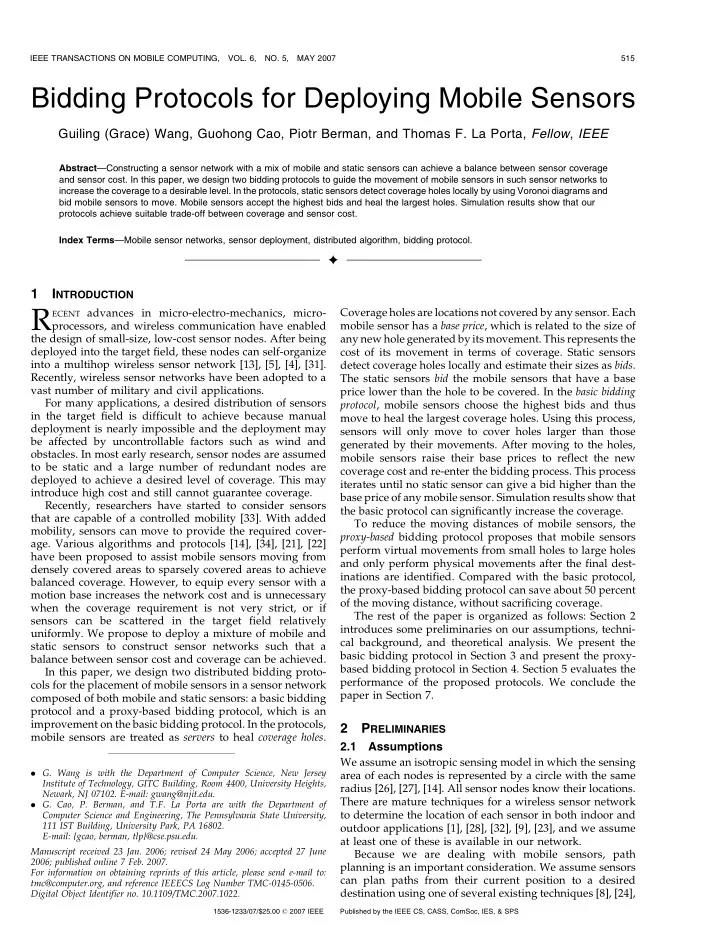

IEEE TRANSACTIONS ON MOBILE COMPUTING, VOL. 6, NO. 5, MAY 2007 515 Bidding Protocols for Deploying Mobile Sensors Guiling (Grace) Wang, Guohong Cao, Piotr Berman, and Thomas F. La Porta, Fellow , IEEE Abstract —Constructing a sensor network with a mix of mobile and static sensors can achieve a balance between sensor coverage and sensor cost. In this paper, we design two bidding protocols to guide the movement of mobile sensors in such sensor networks to increase the coverage to a desirable level. In the protocols, static sensors detect coverage holes locally by using Voronoi diagrams and bid mobile sensors to move. Mobile sensors accept the highest bids and heal the largest holes. Simulation results show that our protocols achieve suitable trade-off between coverage and sensor cost. Index Terms —Mobile sensor networks, sensor deployment, distributed algorithm, bidding protocol. Ç 1 I NTRODUCTION R Coverage holes are locations not covered by any sensor. Each ECENT advances in micro-electro-mechanics, micro- mobile sensor has a base price , which is related to the size of processors, and wireless communication have enabled the design of small-size, low-cost sensor nodes. After being any new hole generated by its movement. This represents the deployed into the target field, these nodes can self-organize cost of its movement in terms of coverage. Static sensors into a multihop wireless sensor network [13], [5], [4], [31]. detect coverage holes locally and estimate their sizes as bids . Recently, wireless sensor networks have been adopted to a The static sensors bid the mobile sensors that have a base vast number of military and civil applications. price lower than the hole to be covered. In the basic bidding For many applications, a desired distribution of sensors protocol , mobile sensors choose the highest bids and thus in the target field is difficult to achieve because manual move to heal the largest coverage holes. Using this process, deployment is nearly impossible and the deployment may sensors will only move to cover holes larger than those be affected by uncontrollable factors such as wind and generated by their movements. After moving to the holes, obstacles. In most early research, sensor nodes are assumed mobile sensors raise their base prices to reflect the new to be static and a large number of redundant nodes are coverage cost and re-enter the bidding process. This process deployed to achieve a desired level of coverage. This may iterates until no static sensor can give a bid higher than the introduce high cost and still cannot guarantee coverage. base price of any mobile sensor. Simulation results show that Recently, researchers have started to consider sensors the basic protocol can significantly increase the coverage. that are capable of a controlled mobility [33]. With added To reduce the moving distances of mobile sensors, the mobility, sensors can move to provide the required cover- proxy-based bidding protocol proposes that mobile sensors age. Various algorithms and protocols [14], [34], [21], [22] perform virtual movements from small holes to large holes have been proposed to assist mobile sensors moving from and only perform physical movements after the final dest- densely covered areas to sparsely covered areas to achieve inations are identified. Compared with the basic protocol, balanced coverage. However, to equip every sensor with a the proxy-based bidding protocol can save about 50 percent motion base increases the network cost and is unnecessary of the moving distance, without sacrificing coverage. when the coverage requirement is not very strict, or if The rest of the paper is organized as follows: Section 2 sensors can be scattered in the target field relatively introduces some preliminaries on our assumptions, techni- uniformly. We propose to deploy a mixture of mobile and cal background, and theoretical analysis. We present the static sensors to construct sensor networks such that a basic bidding protocol in Section 3 and present the proxy- balance between sensor cost and coverage can be achieved. based bidding protocol in Section 4. Section 5 evaluates the In this paper, we design two distributed bidding proto- performance of the proposed protocols. We conclude the cols for the placement of mobile sensors in a sensor network paper in Section 7. composed of both mobile and static sensors: a basic bidding protocol and a proxy-based bidding protocol, which is an improvement on the basic bidding protocol. In the protocols, 2 P RELIMINARIES mobile sensors are treated as servers to heal coverage holes . 2.1 Assumptions We assume an isotropic sensing model in which the sensing . G. Wang is with the Department of Computer Science, New Jersey area of each nodes is represented by a circle with the same Institute of Technology, GITC Building, Room 4400, University Heights, radius [26], [27], [14]. All sensor nodes know their locations. Newark, NJ 07102. E-mail: gwang@njit.edu. There are mature techniques for a wireless sensor network . G. Cao, P. Berman, and T.F. La Porta are with the Department of to determine the location of each sensor in both indoor and Computer Science and Engineering, The Pennsylvania State University, 111 IST Building, University Park, PA 16802. outdoor applications [1], [28], [32], [9], [23], and we assume E-mail: {gcao, berman, tlp}@cse.psu.edu. at least one of these is available in our network. Manuscript received 23 Jan. 2006; revised 24 May 2006; accepted 27 June Because we are dealing with mobile sensors, path 2006; published online 7 Feb. 2007. planning is an important consideration. We assume sensors For information on obtaining reprints of this article, please send e-mail to: can plan paths from their current position to a desired tmc@computer.org, and reference IEEECS Log Number TMC-0145-0506. destination using one of several existing techniques [8], [24], Digital Object Identifier no. 10.1109/TMC.2007.1022. 1536-1233/07/$25.00 � 2007 IEEE Published by the IEEE CS, CASS, ComSoc, IES, & SPS
Recommend
More recommend